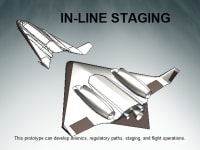There a long history of space vehicles which use boosters to enable a smaller vehicle to reach greater performance. Stages can also help a business plan for aerospace. Private space ventures often wind up on the rocks of bankruptcy. Horizontal launch is often considered the worst case for development costs, but potentially a good case for reusable economies and safety. Horizontal launch can give wings to investment because we don’t need to go to space to go to market.
Small unmanned aircraft are expanding into a multitude of potential new markets. They overlap many old military markets along the way. Wings can allow us to market small affordable aircraft with revolutionary performance potential. A small prototype can develop much bigger markets, including unmanned air cargo markets.
Two aircraft can be staged to achieve greater mission performance. If we use a booster aircraft during the takeoff leg of a mission, we can allow the mission stage to use smaller engines and fuel tanks for a more efficient cruise phase. If both aircraft are unmanned we can tailor the design to cargo for reduced drag, and eliminate crew and life support mass.
An affordable prototype can aid the regulatory path along with the technology. We may see the guidance system as a safety option for manned aircraft in the event of a physical or mental illness in the pilot. Lessons from small unmanned vehicles can make a huge impact on aviation safety in the future.
Rocket engines can open the potential for even greater performance. We may see high speed suborbital cargo missions or reusable suborbital science platforms. With no crew risk they can push the envelope of performance to higher speed and even to orbital missions. Isn’t it natural for a cargo company to expand to delivery to low earth orbit?
Launch vehicles operated from runways can fly to a variety of orbital launch options not available to fixed launchers. They will offer stage separation to salvage missions during booster malfunctions. Customer payloads will return to a gentle landing even from an aborted mission. When vertical launchers fail, they often damage their launch facility. Winged vehicles offer a chance to abort to a safe location or to even return to base.
The only reusable orbiting vehicles in history are the shuttle and the unmanned Air Force X-37. Wings are an asset for safety and reentry. A rocket the size and cost of a small warship should not be disposable. We need to support reusable vehicle development. If we build the path in stages we can repay the investors in stages as well. Only commercial efforts can achieve both technical and financial solutions for our space future. Wings to space: it’s the Wright stuff!
Like this entry?
-
About the Entrant
- Name:David Luther
- Type of entry:individual
- Software used for this entry:SIEMENS NX
- Patent status:patented








